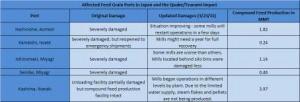The U.S. Grains Council reports the Japanese industry has been making significant strides to regain its normal feed mill production capacity within the next few months.
“Assuming significant escalation of the nuclear power plant issues will not arise and in spite of the horrendous losses suffered in Japan, the Council believes the consumer demand in Japan will remain strong and will drive continued imports of U.S. coarse grains,� said Tommy Hamamoto, USGC director in Japan. “In the short-term, logistical issues will continue to be a problem, but the Japanese feed industry is working hard to recover from the damage. By April or May, the Council is hopeful Japan will recover and return to a somewhat normalcy.�
As previously reported by the Council, four of Japan’s major importing facilities and attached feed mills were severely damaged by the earthquake and subsequent tsunami that struck Japan on March 11. These four facilities account for approximately 3.66 million metric tons of compound feed production per year – around 15 percent of Japan’s total annual compound feed production of 25 million tons. Another mill, which accounts for an additional 15 percent, suffered some damage but compound feed production has already partially resumed.
“Japan is prepared to cover the feed loss by facilities coming back online and increased production in unaffected mills. These [unaffected] mills are sending feed supplies in small vessels to affected areas,� Hamamoto said. “There are currently bottlenecks: the capacity of unaffected ports to unload redirected shipments and storage limitations; impeded passage of ships through channels caused by debris in shipping lanes; increased transportation costs, fuel supplies and shortage of trucks and ships; and power needed for production and processing. The Council hopes those serious bottlenecks will be short-term setbacks in the recovery efforts.�
The Council has heard reports of limited loss of animal herds or flocks.
“Since the majority of livestock and poultry farms are located near Japan’s mountain side (west side of Japan), minimal animal loss is expected from the tsunami. However, logistics of fuels, feed and products continue to be a problem for those farms,� said Hiroko Sakashita, USGC associate director in Japan, adding the Council anticipates knowing the total impact in a few weeks. “In addition, some animal production was affected as facilities had to be evacuated due to elevated radiation levels. This market may further be affected by negative perceptions and false information on their products.�
Exposure to radiation will remain a longer term concern. Japan’s Ministry of Agriculture Forestry and Fisheries released a notice alerting livestock farmers to be cautious and not to feed radioactive-material-contaminated hay, roughage, silage and water to livestock. It recommends that farmers keep their animals indoors if possible. According to Council sources, feed millers in Hokkaido, Chukyo, Kansai and Kyushu have been working around the clock to ensure that sufficient supply of animal feed is available in the damaged area.
“The Council is searching for the best opportunity to get involved with the relief efforts in Japan. Mostly what we hear is to wait, since much of the relief is being provided by the Japanese government,� Hamamoto said. “The Council will continue to monitor the recovery efforts and determine how to best utilize our resources and assets to help mitigate long term damage.�


